1 Hermon 9,232 feet 2 Wadi Hajar 8,537 feet 3 Chaghour ed Dahab 8,400 feet 4 Tal'at Musa 8,208 feet 5 Jabal Abu Baruh 8,170 feet 6 Jabal al Ithnayn 7,898 feet 7 Qornet el Boustane 7,780 feet 8 Jabal Halimah 7,766 feet 9 Ar Rajur 7,745 feet 10 Shaqif 7,732 feet
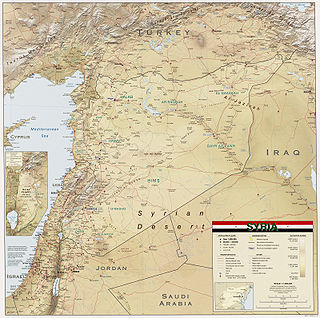
Syria is located in West Asia, north of the Arabian Peninsula, at the eastern end of the Mediterranean Sea. It is bordered by Turkey to the north, Lebanon and Israel to the west and southwest, Iraq to the east, and Jordan to the south. It consists of mountain ranges in the west and a steep area inland. In the east is the Syrian Desert and in the south is the Jabal al-Druze Range. The former is bisected by the Euphrates valley. A dam built in 1973 on the Euphrates created a reservoir named Lake Assad, the largest lake in Syria. The highest point in Syria is Mount Hermon on the Lebanese border at 2,814 metres or 9,232 feet. Between the humid Mediterranean coast and the arid desert regions lies a semiarid steep zone extending across three-quarters of the country, which receives hot, dry winds blowing across the desert. Syria is extensively depleted, with 28 percent of the land arable, 4 percent dedicated to permanent crops, 46 percent utilized as meadows and pastures, and only 3 percent forest and woodland.

Mount Hermon is a mountain cluster constituting the southern end of the Anti-Lebanon mountain range. Its summit straddles the border between Syria and Lebanon and, at 2,814 m (9,232 ft) above sea level, is the highest point in Syria.

The Anti-Lebanon mountains are a southwest–northeast-trending, c. 150 kilometres long mountain range that forms most of the border between Syria and Lebanon. The border is largely defined along the crest of the range. Most of the range lies in Syria.
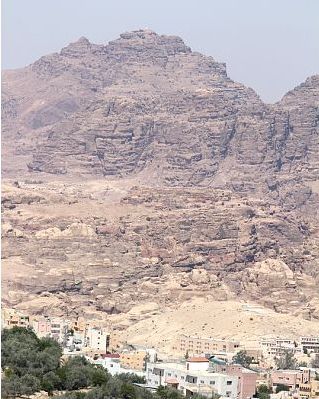
Mount Hor is the name given in the Hebrew Bible to two distinct mountains. One borders the land of Edom in the area south of the Dead Sea, and the other is by the Mediterranean Sea at the Northern border of Israel. The first Mount Hor is especially significant to the Israelites, as Aaron the high priest, brother of Moses, died there.
Zayn al-Abidin may refer to:
Jabal al-Lawz is a mountain located in northwest Saudi Arabia, near the Jordanian border, above the Gulf of Aqaba at 2,580 metres above sea level. The name means 'mountain of almonds'. The peak of Jabal al-Lawz, consists of a light-colored, calc-alkaline granite that is intruded by rhyolite and andesite dikes which generally trend eastward.

Mount Sinai is the mountain at which the Ten Commandments were given to Moses by God, according to the Book of Exodus in the Hebrew Bible. In the Book of Deuteronomy, these events are described as having transpired at Mount Horeb. "Sinai" and "Horeb" are generally considered by scholars to refer to the same place.
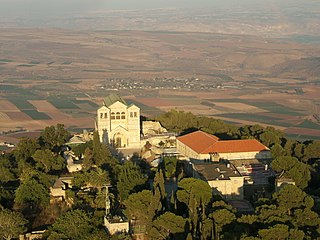
One of the unknowns of the New Testament is the identification of the mountain where Jesus underwent his Transfiguration. The Matthew account of the Transfiguration is as follows:
“And after six days Jesus taketh Peter, James, and John his brother, and bringeth them up into an high mountain apart, And was transfigured before them: and his face did shine as the sun, and his raiment was white as the light. And, behold, there appeared unto them Moses and Elijah talking with him. Then answered Peter, and said unto Jesus, Lord, it is good for us to be here: if thou wilt, let us make here three tabernacles; one for thee, and one for Moses, and one for Elijah. While he yet spake, behold, a bright cloud overshadowed them: and behold a voice out of the cloud, which said, This is my beloved Son, in whom I am well pleased; hear ye him. And when the disciples heard it, they fell on their face, and were sore afraid. And Jesus came and touched them, and said, Arise, and be not afraid. And when they had lifted up their eyes, they saw no man, save Jesus only. And as they came down from the mountain, Jesus charged them, saying, Tell the vision to no man, until the Son of man be risen again from the dead.”

Ghiyath al-Din Shah Rukh Shahi Khan, commonly known as Zayn al-Abidin the Great, was the ninth sultan of the Kashmir Sultanate, ruling first from 1418 to 1419 and then from 1420 to 1470. He was famously called Budshah by his subjects.

The Marjayoun District is a district in the Nabatieh Governorate of Lebanon. The capital of the district is Marjayoun.
Zein is the name of a class of prolamine protein found in maize. It may also refer to:

Mount Bental (Arabic: جبل بنطل, جبل الغرام / ALA-LC: Jabal al-Gharam / "Mountain of Lust" "Jabal Bental"; Hebrew: הר בנטל, Har Bental, "Mount Bental" is a dormant volcano in the North-Eastern part of the Golan Heights, It extends to an elevation of 1,171 Meters above sea level.
Kafraa is a Syrian village located near the Jabal Kafraa mountain in the Hama Subdistrict of the Hama District in the Hama Governorate. According to the Syria Central Bureau of Statistics (CBS), Kafraa had a population of 2,621 in the 2004 census.
Qamhana is a Syrian town located in the Hama Subdistrict of the Hama District in Hama Governorate. It is situated immediately west of the Zayn al-Abidin Mountain. According to the Syria Central Bureau of Statistics (CBS), Qamhana had a population of 13,228 in the 2004 census. Its inhabitants are predominantly Sunni Muslim.
Maardis is a village in central Syria, administratively part of the Suran Subdistrict of Hama District, located 15 kilometers (9.3 mi) north of Hama. It lies in close proximity to the mountain of Jabal Zayn al-Abidin and the hill and spring of Tell Abbada. According to the Syria Central Bureau of Statistics (CBS), Maardis had a population of 6,750 in the 2004 census. Its inhabitants are Sunni Muslims.
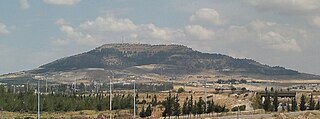
Jabal Zayn al-Abidin is a mountain east of the town of Qamhana and north of Hama in Syria. It has an elevation of 620 meters and is located near Jabal Kafraa. It is the 31st highest mountain in the Hama Governorate and the 544th highest in Syria.
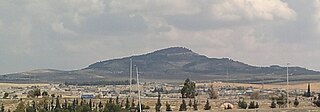
Jabal Kafraa is a mountain near Kafraa in the Hama Governorate in Syria. It has an elevation of 625 meters and is located near Jabal Zayn al-Abidin, it ranks as the 30th highest mountain in Hama and the 540th highest in Syria.
The supplication of Abu Hamza al-Thumali is a dua attributed to Ali ibn al-Husayn, the great-grandson of the Islamic prophet, Muhammad, and the fourth Shia Imam, also known by the honorific title Zayn al-Abidin. Abu Hamzah Al-Thumali, who was a companion of Zayn al-Abidin, is the principal narrator of this supplication, which appears in Eqbal al-a’mal by Sayyed ibn Tawus. It is said that Zayn al-Abidin recited the supplication every evening or dawn during the month of Ramadan.
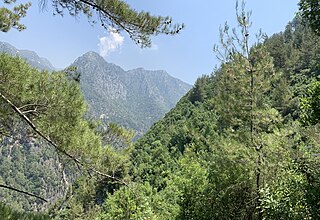
Forests cover 13.6% of Lebanon, and other wooded lands represents 11%. Since 2011, more than 600,000 trees, including cedars and other native species, have been planted throughout Lebanon as part of the Lebanon Reforestation Initiative (LRI). More reforestation efforts are needed. For example, the 40 hectares of Cedrus libani at Al Shouf Cedar Nature Reserve could be expanded to 3,000 hectares. The Friends of the Cedar Forest Committee planted 200,000 cedars, with 180,000 surviving. The Committee goal was to create a corridor connecting the cedar forests o of Bcharre, Ehden, and Tannourine with each other to create an ecosystem in order to make the forests more resilient to future environmental pressures.
Zayn al-Abidin may also refer to: